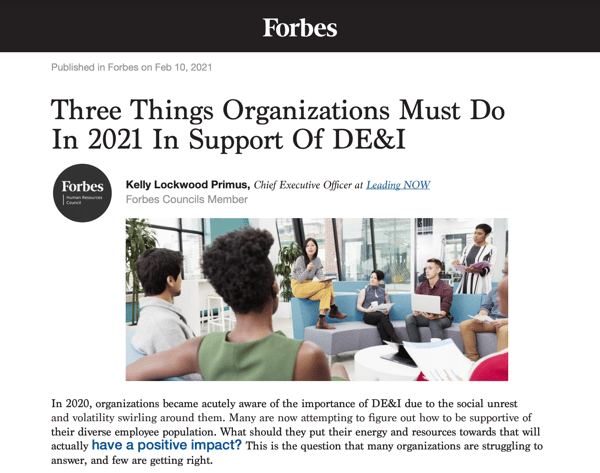
In 2020, organizations became acutely aware of the importance of DE&I due to the social unrest and volatility swirling around them. Many are now attempting to figure out how to be supportive of their diverse employee population. What should they put their energy and resources towards that will actually have a positive impact? This is the question that many organizations are struggling to answer, and few are getting right.
As the CEO of the global advisor Leading NOW, I speak to CEOs, CHROs and CDOs every day, and the most common thing they say is, "We've been hiring diverse employees for years, but our efforts really haven't changed anything…now what should we do?"
My short answer is always the same: It's not just about counting heads. It's about your company's culture. You can't just hire diverse people and expect to see the measurable results you had hoped for. You have to bring all employees across all backgrounds into an inclusive culture.
This is further evidenced in a recent article by the Harvard Business Review that details how "many progressive companies today recognize the conditional nature of the diversity-performance link and have moved beyond 'diversity'... to 'diversity and inclusion.'" Most organizations have been so focused on building a diverse workforce that they've neglected the inclusion part of the equation. To make real progress, people and the organizational cultures they are part of must change.
How do you do this? It starts with leadership. You must ensure your leaders are on board with doing the work necessary to create equity for all and that they are ready to commit to building a truly inclusive culture. In order to build a culture of inclusion, you must incorporate the perspectives of your diverse talent to help guide the organization to make better decisions.
The following are the three things I advise every organization to do in 2021 — regardless of what they've done in the past or where they are on their DE&I journey — to set their organization up for achieving a culture of inclusion.
-
Do a cultural assessment.
It's critical for leaders to understand how their employee base experiences the organization and learn whether their perspectives are aligned with those of the leadership. If you don't do an assessment, you'll never know how to measure the ROI of the DE&I work you have plans to do. Set the foundation by doing a real cultural assessment, not an employee engagement survey, which won't give you the answers you need. What should come out of a culture assessment is an understanding of how your employees experience the culture of the company, how they see the leadership of the company and how they view equity across the employee base. -
Evaluate the readiness of leadership.
Take a temperature check of your leadership team to find out if they are really prepared to support building a culture of inclusion. Are they really willing to make the effort or are they only giving lip service? The results of the cultural assessment will tell your leaders exactly how they are perceived. Share that information with them and provide them guidance on what is expected of them to be seen as truly inclusive leaders.
Note: If you don't have leaders committing to this shift in mindsets and behaviors and they are not supportive of the goal for an inclusive culture, any other work you do will be a waste of your time and the company's resources, so make sure they're on board. -
Balance equity across the organization.
Do an assessment of the policies and procedures of the organization. Make sure there is equity across your employee population. For example, are there mentoring programs, development opportunities, open job listings, etc., for all employees? If not, focus on making the changes necessary to create a solid base of equitable treatment.
To successfully create an inclusive culture, you must understand where you are, take a hard look at your leadership and their support for changing the culture, and then look at the policies and procedures in place within your organization to ensure there isn't bias. What you learn by doing these three steps will drive your strategy for culture change for years to come. One of my favorite quotes is often attributed to Peter Drucker, which says:
"Culture eats strategy for breakfast."
Remember, your leaders are the ones who influence what the culture of your organization is — based on what they do, say and how they act. Leaders are the ones who influence whether people are treated equitably. Be sure to understand exactly how your employees experience your leaders, starting with step one.

--
 This article was originally written for the Forbes Human Resources Council, and published on the Forbes website in February 2021. You can see Kelly Lockwood Primus' other Forbes articles on her author page.
This article was originally written for the Forbes Human Resources Council, and published on the Forbes website in February 2021. You can see Kelly Lockwood Primus' other Forbes articles on her author page.






